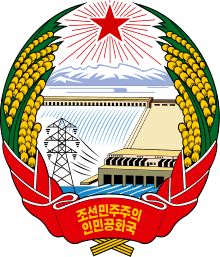Central Military Commission of the Workers' Party of Korea
 |
|---|
| This article is part of a series on the politics and government of North Korea |
|
|
|
Related topics |
The Central Military Commission of the Central Committee of the Workers' Party of Korea (CMC) is an organ of the Central Committee of the Workers' Party of Korea (WPK) which is responsible for coordinating the Party organizations within the Korean People's Army (KPA). One of the CMC’s primary functions is to authorize defense and munitions spending and product orders, and to determine how natural resources and products from military-controlled production units are earmarked and distributed domestically and for sale abroad. According to the WPK Charter, the CMC directs WPK activities in the KPA and is chaired by the WPK Chairman. The CMC relies on a number of organizations to carry out its mandate, including the KPA General Political Department, the WPK Military Department, and the WPK Machine-Building Department. The CMC also uses the WPK Military Affairs Department to transmit guidance and indoctrination of North Korea's reserve military training units.
History
The CMC was established in 1962.[1] A 1982 amendment to the WPK charter is believed to have made the CMC equal to the Central Committee, enabling it (among other things) to elect the WPK leader.[2] The last public listing of the CMC was at the 21st Plenary Session of the 6th Central Committee in December 1993.[3] By the 3rd Conference, seven of its nineteen 1993 members remained; the other twelve had either died, retired or were purged.[3] The CMC was revitalized at the 3rd Conference, with Kim Jong-un and Ri Yong-ho elected as deputy chairmen.[3] Except for his Central Committee membership, this was Kim Jong-un's only title at this time; in many ways, the CMC enabled him to develop a patronage network.[3] New members included Vice Marshal Kim Yong-chun (Minister of People's Armed Forces), General Kim Myong-ruk (Chief of the Operation Bureau of the General Staff), General Yi Pyong-chol (Commander of the Korean People's Air Force), Admiral Chong Myong-do (Commander of the Korean People's Navy), Lieutenant General Kim Yong-chol, Colonel General Choe Kyong-song (heads of the KPA's special forces) General Choe Pu-il and Colonel General Choe Sang-ryo (members of the General Staff).[3] Civilians, such as Jang Song-thaek (head of the Administrative Department), also had seats on the commission.[3] At the 4th Conference, Choe Ryong-hae was appointed CMC deputy chairman; Vice Marshal Hyon Chol-hae, General Ri Myong-su and Kim Rak-gyom were elected to the commission.[4]
Current membership
- Chairman: Marshal Kim Jong-un
- Vice Marshal Hwang Pyong-so
- Premier of the DPRK Pak Pong-ju
- General of the Army Pak Yong-sik, Minister of the People's Armed Forces
- Vice Marshal Ri Myong-su
- General Kim Yong-chol, Director, NDC Reconnaissance General Bureau, North Korea's intelligence service[5]
- Ri Man-gon, Director of the Machine-Building Industry Department of the Workers' Party of Korea
- General Kim Won-hong, Minister of State Security
- General Choe Pu-il, Minister of People's Security
- General Kim Kyong-ok, First Deputy Secretary, WPK Organization and Guidance Department
- General Ri Yong-gil, Chief of the KPA General Staff Department
- Colonel General So Hong-chang, Vice Minister of the People's Armed Forces
See also
References
Footnotes
- ↑ Gause 2011, pp. 226–227.
- ↑ Gause 2013, p. 43.
- 1 2 3 4 5 6 Gause 2013, p. 35.
- ↑ "Kim Jong Un Appointed "First Secretary" of Korean Workers' Party". North Korea Leadership Watch. 11 April 2012. Archived from the original on 13 March 2014. Retrieved 13 March 2014.
- ↑ David E. Sanger and Martin Fackler (January 18, 2015). "N.S.A. Breached North Korean Networks Before Sony Attack, Officials Say". The New York Times. Retrieved January 19, 2015.
Bibliography
Articles, books and journal entries
- Haggard, Stephen; Herman, Luke; Ryu, Jaesung (July–August 2014). "Political Change in North Korea: Mapping the Succession". Asian Survey. University of California Press. 54 (4): 773–780. doi:10.1525/as.2014.54.4.773. JSTOR 10.1525/as.2014.54.4.773.
- Kim, Nam-Sik (Spring–Summer 1982). "North Korea's Power Structure and Foreign Relations: an Analysis of the Sixth Congress of the KWP". The Journal of East Asian Affairs. Institute for National Security Strategy. 2 (1): 125–151. JSTOR 23253510.
- Staff writer (2012 & 2014). Understanding North Korea. Ministry of Unification. Check date values in:
|year=(help)
Books
- Buzo, Adrian (1999). The Guerilla Dynasty: Politics and Leadership in North Korea. I.B. Tauris. ISBN 1860644147.
- Gause, Ken E. (2011). North Korea Under Kim Chong-il: Power, Politics, and Prospects for Change. ABC-CLIO. ISBN 0313381755.
- — (2013). "The Role and Influence of the Party Apparatus". In Park, Kyung-ae; Snyder, Scott. North Korea in Transition: Politics, Economy, and Society. Rowman & Littlefield. pp. 19–46. ISBN 1442218126.
- Kim, Samuel (2000). "North Korean Informal Politics". Informal Politics in East Asia. Cambridge University Press. ISBN 0521645387.
- Lankov, Andrei (2007). Crisis in North Korea: The Failure of De-Stalinization, 1956. University of Hawaii Press. ISBN 0824832078.
- Suh, Dae-sook (1988). Kim Il Sung: The North Korean Leader (1st ed.). Columbia University Press. ISBN 0231065736.